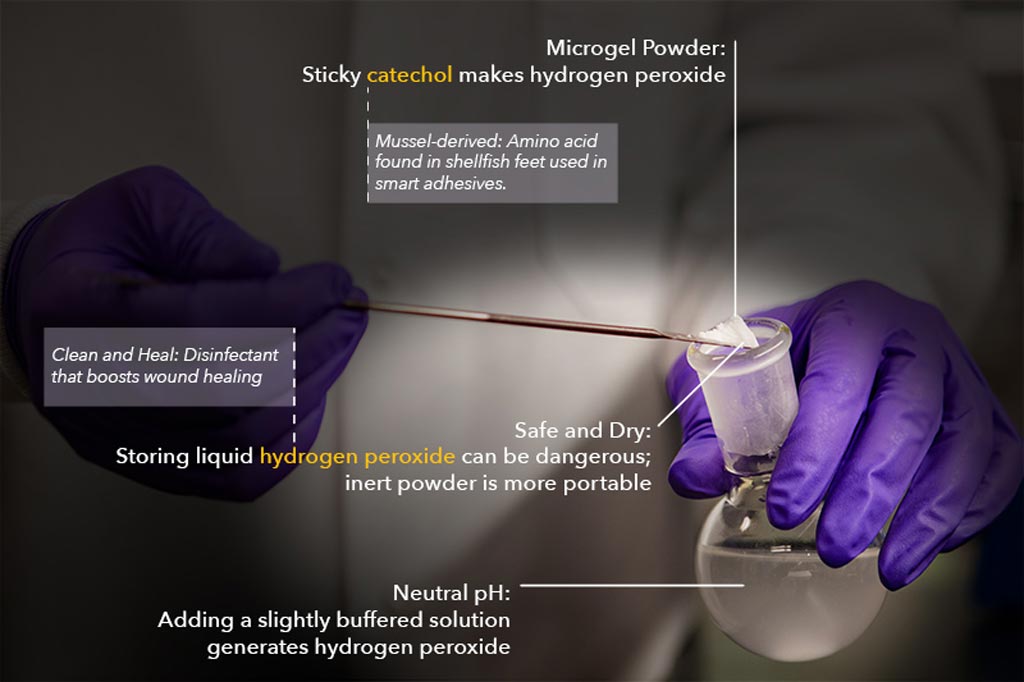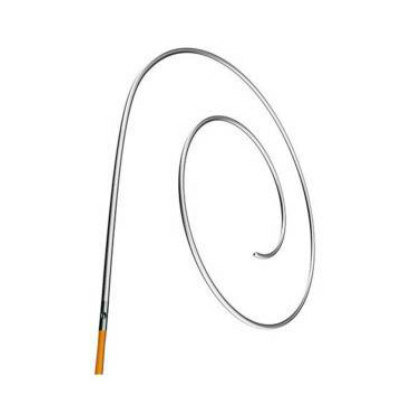Hydrogen Peroxide Microgel Powder Helps Wounds Heal Better
|
By HospiMedica International staff writers Posted on 27 Nov 2018 |

Image: A new study asserts that microgel powder can disinfect wounds (Photo courtesy of MTU).
A novel microgel powder that generates antipathogenic levels of hydrogen peroxide (H2O2) through simple rehydration could provide a portable disinfectant, according to a new study.
Developed by researchers at Michigan Technological University (MTU; Houghton, USA), the microgel powder is based on Catechol, an adhesive moiety found in mussel adhesive proteins. When catechol autoxidizes following contact with solutions with physiological pH, it generates 1-5 mM of H2O2 for up to four days. The researchers studied the microgel's effects on thin-walled and gram-positive Staphylococcus epidermidis, the more impenetrable and gram-negative Escherichia coli--two common bacterial strains--and also against two viruses, bovine viral diarrhea virus (BVDV) and porcine parovirus (PPV).
The results revealed that sustained release of the low concentration H2O2 (several orders of magnitude lower than that previously reported for antipathogenic activity) was antimicrobial against the bacteria, and antiviral against both extremely resistant non-enveloped PPV and the easier to inactivate enveloped BVDV. Most notably, the microgels reduced the infectivity of the more biocide resistant non-envelope virus by a 3 log reduction value, a 99.999% reduction. The study was published on October 26, 2018, in Acta Biomaterialia.
“The microgels do not contain a reservoir for storing the reactive H2O2 and can potentially function as a lightweight and portable dried powder source for the disinfectant for a wide range of applications,” said senior author biomedical engineer Bruce Lee, PhD. “We haven't tested any antibiotic-resistant bacterial strains yet, but the more we can get away from using antibiotics in the first place, the better. We want to demonstrate under what conditions it promotes healing, and how a cell responds to it.”
Microgels are like tiny bubbles of Jell-o, in essence a polymer network. To the naked eye, the dry form is a nondescript powder. But when suspended in a solution with neutral or a slightly alkaline pH, such as distilled water or a saline solution, the micron-sized microgels start generating H2O2. Once the microgel powder is dried again, the material basically resets and can be reused, and its potency remains high. The powder can be used in space stations, remote areas, war zones, or practically anywhere.
Related Links:
Michigan Technological University
Developed by researchers at Michigan Technological University (MTU; Houghton, USA), the microgel powder is based on Catechol, an adhesive moiety found in mussel adhesive proteins. When catechol autoxidizes following contact with solutions with physiological pH, it generates 1-5 mM of H2O2 for up to four days. The researchers studied the microgel's effects on thin-walled and gram-positive Staphylococcus epidermidis, the more impenetrable and gram-negative Escherichia coli--two common bacterial strains--and also against two viruses, bovine viral diarrhea virus (BVDV) and porcine parovirus (PPV).
The results revealed that sustained release of the low concentration H2O2 (several orders of magnitude lower than that previously reported for antipathogenic activity) was antimicrobial against the bacteria, and antiviral against both extremely resistant non-enveloped PPV and the easier to inactivate enveloped BVDV. Most notably, the microgels reduced the infectivity of the more biocide resistant non-envelope virus by a 3 log reduction value, a 99.999% reduction. The study was published on October 26, 2018, in Acta Biomaterialia.
“The microgels do not contain a reservoir for storing the reactive H2O2 and can potentially function as a lightweight and portable dried powder source for the disinfectant for a wide range of applications,” said senior author biomedical engineer Bruce Lee, PhD. “We haven't tested any antibiotic-resistant bacterial strains yet, but the more we can get away from using antibiotics in the first place, the better. We want to demonstrate under what conditions it promotes healing, and how a cell responds to it.”
Microgels are like tiny bubbles of Jell-o, in essence a polymer network. To the naked eye, the dry form is a nondescript powder. But when suspended in a solution with neutral or a slightly alkaline pH, such as distilled water or a saline solution, the micron-sized microgels start generating H2O2. Once the microgel powder is dried again, the material basically resets and can be reused, and its potency remains high. The powder can be used in space stations, remote areas, war zones, or practically anywhere.
Related Links:
Michigan Technological University
Latest Critical Care News
- Ventricular Assist Device Offers Long-Term Use in Children Waiting for Donor Heart
- Precision Approach Improves Immunotherapy Effectiveness for ICU Patients with Sepsis
- Soft Robots Could Donate Their Heart to Humans
- Bioadhesive Strategy Prevents Fibrosis Around Device Implants on Peripheral Nerves
- Miniature Non-Invasive Robotic Catheters to Improve Infertility Treatments
- Stick-On Patch Monitors Baby's Movements In Utero
- EEG-Based AI Technology Accurately Diagnoses Alzheimer’s and Dementia
- Robot Lymphatic System Paves Way for Self-Powered Wearables and Machines
- Focused Ultrasound Technique Successfully Treats Pediatric Brain Cancer
- Nasal Drops Fight Brain Tumors Noninvasively
- AI Helps Optimize Therapy Selection and Dosing for Septic Shock
- Glowing Bacteria ‘Pills’ for Detecting Gut Diseases Could Eliminate Colonoscopies
- Skin-Permeable Polymer Patch Delivers Insulin Non-Invasively Through Skin
- Nanogel Technology Almost 100% Effective in Destroying Drug-Resistant Bacteria Within Hours
- Wearable Ultrasound Sensor Delivers Noninvasive Treatment Without Surgery
- Gel-Free ECG System to Transform Heart Health Diagnosis
Channels
Surgical Techniques
view channel
Minimally Invasive Surgery Proven Safe and Effective for Complex ‘Whipple’ Procedure
Tumors of the pancreatic head often require a highly complex operation known as pancreatoduodenectomy or the Whipple procedure. This surgery involves removing multiple structures and creating several internal... Read more
Catheter-Based Procedures Offer Less Invasive Option for Treatment of Valvular Disease
Valvular heart disease, caused by tight or leaky valves between heart chambers, affects up to 10% of older adults and leads to more than 120,000 deaths globally each year. Traditional open-heart surgery... Read morePatient Care
view channel
Revolutionary Automatic IV-Line Flushing Device to Enhance Infusion Care
More than 80% of in-hospital patients receive intravenous (IV) therapy. Every dose of IV medicine delivered in a small volume (<250 mL) infusion bag should be followed by subsequent flushing to ensure... Read more
VR Training Tool Combats Contamination of Portable Medical Equipment
Healthcare-associated infections (HAIs) impact one in every 31 patients, cause nearly 100,000 deaths each year, and cost USD 28.4 billion in direct medical expenses. Notably, up to 75% of these infections... Read more
Portable Biosensor Platform to Reduce Hospital-Acquired Infections
Approximately 4 million patients in the European Union acquire healthcare-associated infections (HAIs) or nosocomial infections each year, with around 37,000 deaths directly resulting from these infections,... Read moreFirst-Of-Its-Kind Portable Germicidal Light Technology Disinfects High-Touch Clinical Surfaces in Seconds
Reducing healthcare-acquired infections (HAIs) remains a pressing issue within global healthcare systems. In the United States alone, 1.7 million patients contract HAIs annually, leading to approximately... Read moreHealth IT
view channel
EMR-Based Tool Predicts Graft Failure After Kidney Transplant
Kidney transplantation offers patients with end-stage kidney disease longer survival and better quality of life than dialysis, yet graft failure remains a major challenge. Although a successful transplant... Read more
Printable Molecule-Selective Nanoparticles Enable Mass Production of Wearable Biosensors
The future of medicine is likely to focus on the personalization of healthcare—understanding exactly what an individual requires and delivering the appropriate combination of nutrients, metabolites, and... Read moreBusiness
view channel
Philips and Masimo Partner to Advance Patient Monitoring Measurement Technologies
Royal Philips (Amsterdam, Netherlands) and Masimo (Irvine, California, USA) have renewed their multi-year strategic collaboration, combining Philips’ expertise in patient monitoring with Masimo’s noninvasive... Read more
B. Braun Acquires Digital Microsurgery Company True Digital Surgery
The high-end microsurgery market in neurosurgery, spine, and ENT is undergoing a significant transformation. Traditional analog microscopes are giving way to digital exoscopes, which provide improved visualization,... Read more
CMEF 2025 to Promote Holistic and High-Quality Development of Medical and Health Industry
The 92nd China International Medical Equipment Fair (CMEF 2025) Autumn Exhibition is scheduled to be held from September 26 to 29 at the China Import and Export Fair Complex (Canton Fair Complex) in Guangzhou.... Read more













